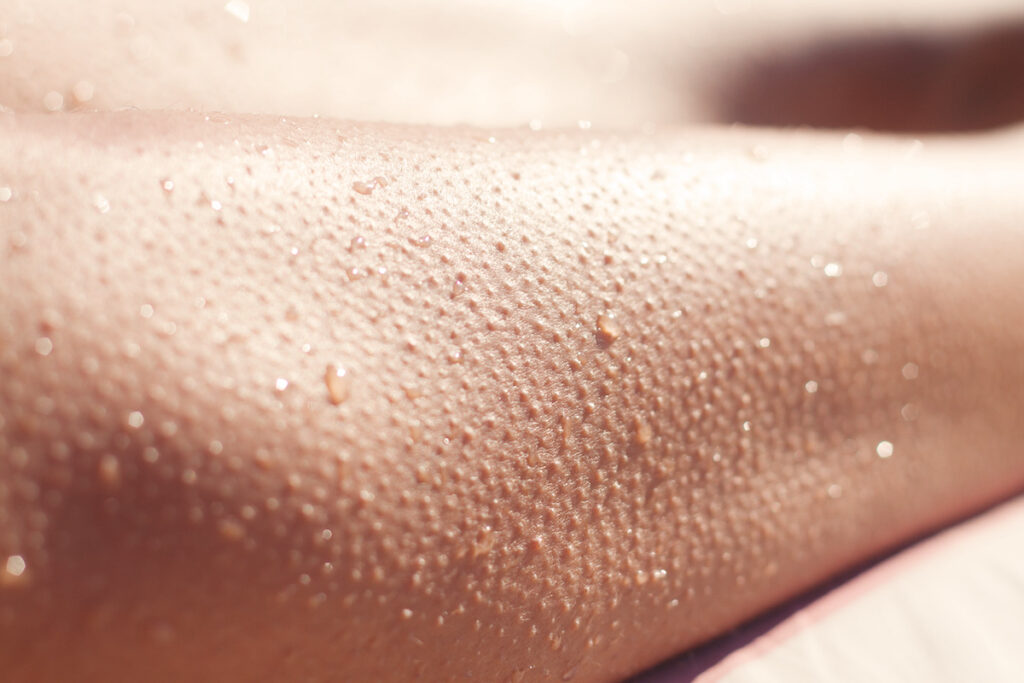
If you have noticed that you have goosebumps on your body even when you are not cold, you may actually have a skin condition called keratosis pilaris, also known as chicken skin. You certainly are not the only one with this condition–keratosis pilaris is so common that about 50% to 80% of teenagers and 40% of adults will develop these bumps at some point in their lives. Most people who have chicken skin are most bothered by the rough texture of their skin and the small hard bumps. However, laser treatment can be used to alleviate the symptoms of this skin condition.
What is Keratosis Pilaris?
Keratosis pilaris is a common skin issue that causes small bumps on the skin. This condition develops because of a buildup of keratin, the natural protein that helps protect the skin from infections. Keratin blocks hair follicles when it builds up, causing bumps that resemble chicken skin (nicknamed because the skin’s appearance resembles that of a featherless chicken). While it is not known exactly why the keratin starts to collect, it does seem to be prevalent among those that have dry skin, and it is often worse in the winter when there is less moisture in the air. It can also be linked to genetics. In fact, between 30%-50% of those with this skin condition have a positive family history.
Symptoms of Keratosis Pilaris
Those who suffer from chicken skin often have small bumps in a particular area of the skin. The dots can be flesh-colored or red, and sometimes accompanied by swelling. One of the biggest complaints of this condition is that the skin feels rough and dry. It can occur on the arms, shoulders, back, thighs, and buttocks, and occasionally on the face.
Keratosis pilaris is often seen in children and teenagers and while some are fortunate enough to outgrow it, others have it as adults. As mentioned, genetics can play a role, but it can also be a result of diabetes, pregnancy or atopic dermatitis. While there is no permanent cure for this there are treatments available to lessen its appearance and improve the skin’s texture.
Treatments for Keratosis Pilaris
While this skin condition cannot be completely cured, there are a few ways to prevent skin follicles from getting blocked. For example, it is recommended to avoid hot showers and limit time in the water. Another way to keep moisture in the air is with the use of humidifiers which can keep the skin from getting dried out.
For those with chicken skin, keeping the skin moisturized is essential. Look for a thicker lotion or cream or one that is specifically for eczema. As for treatments, there are several that can help reduce the appearance of bumps:
Chemical Exfoliants: A topical cream or exfoliant that contains alpha-hydroxy acid, lactic acid, salicylic acid, or urea. These acids will remove dead cells from the surface of the skin to keep hair follicles unblocked. Several specifically target bumps with a combination of acids in addition to pumice beads to unlock pores. The exfoliant should be used daily for several weeks in order to see results.
Topical Retinoids: Topical retinoids keep hair follicles from becoming clogged. While these products are often used for acne, they can also be used to treat chicken skin. This treatment will also require daily application for several weeks in order to work.
The American Academy of Dermatology Association (AAD) recommends creamy moisturizers to help relieve dryness and itchiness be used in conjunction with an exfoliator like a loofah.
Laser Treatment for Keratosis Pilaris
Laser treatments are an effective way to treat a variety of different skin conditions, including keratosis pilaris. Laser hair removal works to treat this skin condition because it removes inflammation and redness from the skin.
Here’s how it works: a pulsed dye laser uses wavelengths of light to target the pigment or melanin of the hair follicle. As the pigment absorbs the wavelengths from the laser, the hair follicle dies, and stops hair growth. This also prevents the keratin from clogging the hair follicle, so the bumps do not form.
Those that have keratosis pilaris have reported an improvement in not only the texture but the overall appearance of their skin after having laser hair removal in the affected area. Most often, several treatments are needed to achieve the maximum improvement of the skin.
After Laser Treatment
Laser hair removal is safe for most people, although some may experience minor skin irritation like redness and swelling depending on their skin and hair color, and skin type. Talking to an experienced medical professional will determine if you are a candidate for this procedure. After laser treatment, it is important that the skin is moisturized several times a day. Keratosis pilaris can come back if it is not continually treated so it is also important to keep up with a treatment schedule.
Laser treatments should only be done by professionals who are skilled in performing the procedure. Working with a knowledgeable professional who has been trained to treat keratosis pilaris with a laser, will ensure that the treatment will be personalized to your specific skin concerns. Lasers are an effective way to reduce the rough texture of the skin and improve the appearance of your skin. To find out more about how our BBL laser hair removal can help improve your keratosis pilaris symptoms, contact us today.












